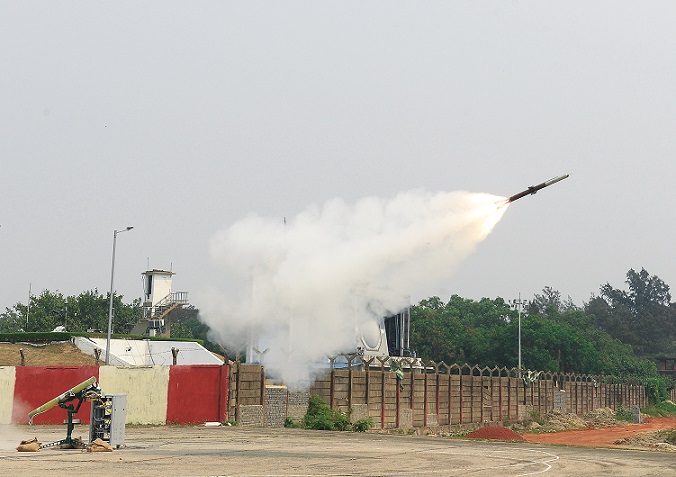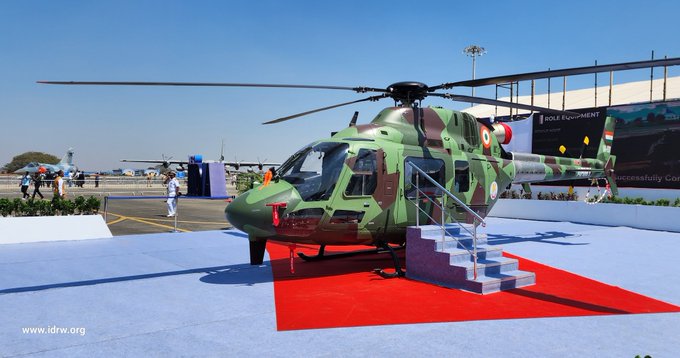SOURCE: IDRW.ORG

India’s push toward self-reliance in defense technology reached a new milestone at Aero India 2025, held in Bengaluru from February 10-14. NewSpace Research and Technologies, a Bengaluru-based aerospace startup, unveiled its Abhimanyu Collaborative Combat Aircraft (CCA)—a jet-powered unmanned aerial system (UAS) designed to operate alongside the Indian Navy’s MiG-29K fighters. Confirmed by the company during the exhibition, the Abhimanyu is engineered for carrier-based takeoff and landing, positioning it as a critical component of the Navy’s Naval Collaborative Combat Air Vehicle (N-CCAV) program. With this development, India is stepping boldly into the era of manned-unmanned teaming (MUM-T), enhancing its naval air power with a versatile and innovative platform.
Sporting a modest 4-meter (13-foot) wingspan, the Abhimanyu is notably smaller than many CCAs under development globally, such as the U.S.’s XQ-67A or Australia’s MQ-28 Ghost Bat. Yet, NewSpace sees this compact size as an advantage rather than a limitation. The company envisions the Abhimanyu as a stepping stone—a cost-effective, scalable solution that paves the way for more advanced platforms down the line. Its diminutive stature allows a carrier to deploy multiple units, offering tactical flexibility and the ability to overwhelm adversaries through sheer numbers.
Continue readingSOURCE: IDRW.ORG

India’s Twin Engine Deck-Based Fighter (TEDBF) program, a cornerstone of the Indian Navy’s future carrier-based aviation strategy, is progressing steadily despite swirling speculation about the Navy’s long-term pursuit of a full fifth-generation jet. An official from the Aeronautical Development Agency (ADA), speaking exclusively to idrw.org, confirmed that the Navy remains fully committed to the TEDBF, classified as a “5th Gen Minus” fighter.
This statement comes amid reports suggesting the Navy might pivot to a stealthier, fifth-generation platform under its Vision 2047 roadmap. Addressing these concerns, the ADA official emphasized that the program is on track, with the Preliminary Design Review (PDR) slated for completion later in 2025, and dismissed any plans to transform the TEDBF into a fully-fledged fifth-generation jet with features like an Internal Weapons Bay (IWB).
Continue readingSOURCE: AFI

Christopher Clary, a political scientist at the University of Albany, recently highlighted a troubling trend for India’s air power, drawing on data from the International Institute for Strategic Studies (IISS) Military Balance. Between 2014 and 2024, China bolstered its fleet by adding 435 fighter and ground attack aircraft, while Pakistan expanded its own by 31. In stark contrast, India’s fleet shrank by 151 aircraft over the same period, raising concerns about its aerial combat readiness amid growing regional tensions.
India’s fighter jet strength, once a formidable force, has been eroded by the retirement of aging Soviet-era aircraft like the MiG-21, outpacing new inductions. With the Indian Air Force (IAF) currently operating 31 squadrons against a sanctioned strength of 42, the gap in capability is evident. Clary’s analysis underscores the urgency for India to reverse this decline, particularly as its neighbors strengthen their military aviation capabilities.
Continue readingSOURCE: AFI

In a significant boost to India’s defense capabilities, Bharat Electronics Limited (BEL) handed over the 49th Weapon Locating Radar (WLR-Plains), known as Swathi, to the Indian Army on March 05, 2025. Developed indigenously in collaboration with the Electronics and Radar Development Establishment (LRDE), this milestone underscores BEL’s commitment to delivering cutting-edge technology well ahead of schedule.
The Swathi WLR is a sophisticated radar system designed to detect and track incoming artillery shells, mortars, and rockets, while simultaneously pinpointing the location of enemy weapons. Tailored for operations in plains terrain, it provides the Indian Army with a critical tactical advantage by enabling rapid counter-battery fire. The system’s indigenous development highlights India’s growing prowess in defense electronics and radar technology, aligning with the “Make in India” and “Atmanirbhar Bharat” initiatives.
Continue readingSOURCE: AFI

The Pakistan Air Force (PAF) has been strategically evolving its fighter fleet with a long-term vision of operating an all-5th generation fighter force by 2047. This ambitious modernization plan aligns with Pakistan’s national defense objectives and aims to maintain regional air superiority. PAF’s roadmap involves three key 5th generation fighter jet programs, each playing a crucial role in achieving this transformation.
At the heart of PAF’s future plans is Project Azm, a homegrown 5th generation fighter jet program spearheaded by the Pakistan Aeronautical Complex (PAC) and the National Aerospace Science and Technology Park (NASTP). First announced in 2017, Project Azm aims to develop an advanced stealth fighter jet featuring next-generation avionics, advanced sensor fusion, and indigenous weapon systems. While progress on the program remains classified, Pakistan has been collaborating with China and Turkey for technology transfer and expertise.
Continue readingSOURCE: AFI

SEC DRVAN INNOVENTIONS PRIVATE LIMITED a Hyderabad-based drone startup, is rapidly emerging as a key player in India’s defence and aerospace sector. With a sharp focus on Aerial Target Systems and Long-Endurance Surveillance Unmanned Aerial Vehicles (UAVs), the company is driving innovation through strategic collaborations with leading foreign, national, and international firms. These partnerships have enabled SEC DRVAN Innoventions to develop advanced, next-generation solutions tailored to modern defence needs.
The startup is gearing up for a significant milestone with its participation in the International Defence Exhibition and Conference (IDEX) 2025, set to take place in Abu Dhabi. IDEX is one of the world’s premier platforms for showcasing cutting-edge military technologies, and SEC DRVAN Innoventions plans to unveil its latest products at the event. This debut on the global stage highlights the company’s ambition to elevate UAV capabilities, meet critical defence requirements, and strengthen international ties in the aerospace and defence industries.
Continue readingSOURCE: AFI
)
Solar Defence and Aerospace Ltd, a subsidiary of Solar Industries, has secured a ?239-crore contract from the Ministry of Defence to supply multi-mode hand grenades, reinforcing its role as a key player in India’s defense manufacturing sector. Under the agreement, the company is tasked with delivering these critical defense products within a year, further bolstering the nation’s security capabilities.
The multi-mode hand grenades, known for their versatility, can operate in both offensive and defensive modes, making them a vital asset for the armed forces. This contract highlights the growing reliance on indigenous firms to meet the defense needs of the country, aligning with the government’s “Make in India” and “Atmanirbhar Bharat” initiatives aimed at achieving self-reliance in defense production.
Continue readingSOURCE: IANS

As of January 31, a total of 144 fishermen from Gujarat remain in Pakistani jails, the state government informed the Legislative Assembly on Wednesday. In the one year from February 1, 2023, to January 21, 2024, Pakistan released 432 Gujarat fishermen. However, no fishermen have been released since then.
The number of arrests of Gujarat fishermen by Pakistan has drastically decreased, the government said. Between February 1, 2023, and January 31, 2024, only nine Gujarat fishermen were detained by Pakistani authorities. In the following year, 13 fishermen were arrested, marking a slight increase.
Continue readingSOURCE: RAUNAK KUNDE / NEWS BEAT / IDRW.ORG

The Aeronautical Development Agency (ADA) and Hindustan Aeronautics Limited (HAL) are embarking on an ambitious initiative to integrate the Tejas MkII fighter jet with semi-autonomous unmanned aerial vehicles (UAVs), commonly referred to as CATS Warrior “loyal wingmen.” This cutting-edge project aims to leverage advanced artificial intelligence (AI) technologies for real-time coordination and mission execution between manned and unmanned platforms.
Equipped with state-of-the-art AI, these drones will seamlessly collaborate with the Tejas MkII, sharing mission data and dynamically adapting to evolving combat scenarios. This capability is particularly valuable in high-threat environments, where coordinated manned-unmanned operations can outmanoeuvre and overwhelm adversaries.
Continue readingSOURCE: RAUNAK KUNDE / NEWS BEAT / IDRW.ORG

The Indian Navy has expressed interest in the Defence Research and Development Organisation’s (DRDO) Very Short Range Air Defence System (VSHORADS) to bolster the defensive capabilities of its frontline warships. This advanced system, originally designed for land-based applications, is being considered for adaptation as a Close-In Weapon System (CIWS), enhancing the Navy’s ability to counter a wide range of aerial and surface threats.
The VSHORADS is a man-portable air defence system (MANPADS) equipped with advanced technologies, including a dual-band infrared seeker and a lightweight design for high mobility. When modified for naval applications, the VSHORADS-based CIWS will provide an additional layer of defence, complementing existing missile systems like the Vertical Launch Short Range Surface to Air Missile (VL-SRSAM).
Continue readingSOURCE: RAUNAK KUNDE / NEWS BEAT / IDRW.ORG

The Indian Navy is set to bolster its underwater capabilities with plans to equip three additional Enhanced Scorpene-class submarines with advanced submarine-launched missiles and integrate them with unmanned underwater vehicles (UUVs). These submarines will be procured from Mazagon Dock Shipbuilders Limited (MDL) under Project-75, showcasing a significant step forward in India’s naval strategy and technological integration.
The Enhanced Scorpène-class submarines, an iteration of the Kalvari-class already in service, are designed to offer superior stealth, endurance, and combat capabilities. The introduction of submarine-launched missiles marks a strategic enhancement, providing the Indian Navy with greater tactical flexibility and the ability to engage surface and land targets from underwater, thereby extending the reach and impact of naval operations.
Continue readingSOURCE: AFI

India’s ambitious Light Utility Helicopter (LUH), developed by Hindustan Aeronautics Limited (HAL), has hit turbulence amid revelations of unresolved design issues flagged by a senior experimental test pilot (ETP). Capt K.P. Sanjeev Kumar, a former Indian Navy test pilot and prolific aviation blogger, detailed these concerns in a March 2025 post on his website, www.kaypius.com. Drawing from confirmed sources and personal interactions, Kumar recounts how a veteran IAF test pilot, employed by HAL, escalated serious safety concerns about the LUH—particularly its autorotation and directional stability—to the company’s leadership as early as November 2023. Despite internal reviews and customer demonstrations at Aero India 2025, these issues remain unaddressed, casting a shadow over the program’s credibility and raising questions about the certification process.
The whistleblower, described as a senior IAF veteran and ETP with deep ties to the LUH program, first raised red flags early in its development. According to Kumar, the pilot warned HAL officials of “serious design issues” that threatened the helicopter’s safety and performance. As HAL prepared to sign a contract for 12 Limited Series Production (LSP) units in 2023—part of a broader plan to supply 187 LUHs to the Indian Army and Air Force—the ETP escalated his concerns to the Chairman of HAL in November 2023, citing critical gaps in flight testing that had not been resolved.
Continue readingSOURCE: AFI

India is making strides in the realm of stealth technology with the development of an innovative plasma stealth device, a cutting-edge system designed to reduce the radar cross-section (RCS) of military assets. Recent advancements showcased by the country include the use of rectangular and elliptical tiles integrated into plasma chambers, arranged in arrays to generate plasma with precisely controlled parameters. This technology, aimed at absorbing microwave signals, has undergone rigorous testing in both controlled and real-world environments, marking a significant step forward in India’s defense capabilities.
The plasma stealth device operates on the principle of using ionized gas—plasma—to interact with and attenuate electromagnetic waves, such as those emitted by radar systems. By creating a plasma layer around a target, the device can either absorb or deflect incoming radar waves, effectively reducing the object’s visibility to detection systems. The rectangular and elliptical tiles, developed specifically for this purpose, serve as the building blocks of plasma chambers that produce the necessary plasma conditions. These chambers are engineered to optimize the density and distribution of the plasma, ensuring maximum effectiveness in microwave absorption.
Continue readingSOURCE: AFI

India’s defense industry took a bold step onto the global stage at the International Defence Exhibition and Conference (IDEX) 2025, held in Abu Dhabi from February 17-21. Tata Advanced Systems Limited (TASL) unveiled its Light Armoured Multipurpose Vehicle (LAMV) 4×4 for the first time, showcasing a NATO-compliant, indigenously developed platform designed to meet the evolving needs of modern armed forces. The debut has already generated significant buzz, with inquiries pouring in from multiple Middle Eastern and African nations, signaling a promising export trajectory for this versatile armored vehicle.
The LAMV’s unveiling at IDEX 2025 marked a milestone for TASL, a key player in India’s burgeoning defense sector. Designed to blend mobility, protection, and adaptability, the 4×4 vehicle was pitched as a game-changer for missions ranging from reconnaissance to troop transport and tactical operations. With a sleek, modular design and a gross vehicle weight of 10,200 kilograms, the LAMV offers ballistic protection up to STANAG 4569 Level 2 and mine resistance at Levels 2a and 2b—capable of withstanding small arms fire and explosive threats. Its air-transportable frame and maximum speed of 100 kmph further enhance its appeal for rapid deployment in diverse terrains.
Continue readingSOURCE: AFI

The Indian Navy is poised to enhance its maritime prowess with the addition of two advanced stealth frigates, INS Himagiri and INS Udaygiri, as part of Project 17A. These state-of-the-art warships, belonging to the Nilgiri-class, are set to significantly elevate the Navy’s combat capabilities across multiple warfare domains, including anti-air, anti-surface, and anti-submarine operations. Their induction underscores India’s growing naval strength and commitment to self-reliance in defense manufacturing.
Built with an impressive 75 percent indigenous components, INS Himagiri and INS Udaygiri exemplify the success of India’s “Make in India” initiative. Constructed under Project 17A—a ?45,000-crore endeavor to deliver seven stealth frigates—these warships are being crafted by Mazagon Dock Shipbuilders Limited (MDL) in Mumbai and Garden Reach Shipbuilders & Engineers (GRSE) in Kolkata. The high level of indigenization reflects a maturing defense ecosystem, with local industries supplying critical systems, from propulsion to weaponry.
Continue reading